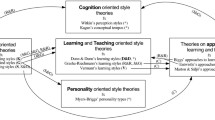Abstract
Olsen is right to note what can be done with a good theory and the right machine. His particular theory, however, is not transferable to literary studies. If we need a new model, I would suggest that cognitive science can provide a few interesting ones. I have begun to do some work based on David Marr's VISION, in which he hypothesizes two levels of processing within the visual module. My speculation has been on the parallel existence of distinguishable levels of conceptual or language organization which would correspond to the viewer and object centered perspectives Marr describes for vision. I propose to explore the possibility that we may find here the model for the existence of stylistic individualism within overarching historical stylistic generalizations, and even more, that this may be what feminists are searching for when they try to resist being coopted by the masculine language of objectivity.
Similar content being viewed by others
References
Bloom, Harold.The Anxiety of Influence. New York: Oxford University Press, 1973.
Chomsky, Noam.Reflections on Language. New York: Pantheon, 1975.
Cixous, Hélène. “The Laugh of the Medusa.” Trans. Keith Cohen and Paula Cohen. InThe Signs Reader: Women, Gender, and Scholarship. Eds. Elizabeth Abel and Emily K. Abel. Chicago: University of Chicago Press, 1983, pp. 279–97.
Culler, Jonathan.On Deconstruction. Ithaca, New York: Cornell University Press, 1983.
Fish, Stanley. “What is Stylistics and Why Are They Saying Such Terrible Things About It?” InApproaches to Poetics. Ed. Seymour Chatman. New York: Columbia University Press, 1973, pp. 109–52.
Gilbert, Sandra and Susan Gubar.No Man's Land: The Place of the Woman Writer in the Twentieth Century. New Haven: Yale University Press, 1987.
Gombrich, E.H.Art and Illusion: A Study in the Psychology of Pictorial Representation. Princeton, New Jersey: Princeton University Press, 1969.
Hesse, Mary. “The Cognitive Claims of Metaphor.”Journal of Speculative Philosophy, 2, 1 (1988), 1–16.
Jackendoff, Ray.Consciousness and the Computational Mind. Cambridge: MIT Press, 1987.
Jones, Ann Rosalind. “Writing the Body: Toward an Understanding ofL'Ecriture Féminine.” InThe New Feminist Criticism: Essays on Women, Literature, and Theory. Ed. Elaine Showalter. New York: Pantheon, 1985, pp. 361–77.
Kristeva, Julia. “A New Type of Intellectual: The Dissident.” Trans. Seán Hand. InThe Kristeva Reader. Ed. Toril Moi. Oxford: Blackwell, 1986a, pp. 292–300.
Kristeva, Julia. “Women's Time.” Trans. Alice Jardine and Harry Blake. InThe Kristeva Reader. Ed. Toril Moi. Oxford: Blackwell, 1986b, pp. 187–213.
Marr, David.Vision. San Francisco: W.H. Freeman, 1982.
Moi, Toril.Sexual/Textual Politics. London: Routledge, 1985.
Ortony, Anthony, ed.Metaphor and Thought. Cambridge: Cambridge University Press, 1979.
Popper, Karl and John C. Eccles.The Self and Its Brain: An Argument for Interactionism. London: Routledge, 1977.
Showalter, Elaine. “Feminist Criticism in the Wilderness.”Critical Inquiry, 8, 2 (1981), 179–205.
Spolsky, Ellen.Gaps in Nature: Literary Interpretation and the Modular Mind. Albany, New York: SUNY, 1993.
Author information
Authors and Affiliations
Additional information
Ellen Spolsky teaches English literature and literary theory and is the Director of the Lechter Institute for Literary Research at Bar-Ilan University, Israel. Her latest book is Gaps in Nature: Literary Interpretation and the Modular Mind(SUNY Press, 1993).
Rights and permissions
About this article
Cite this article
Spolsky, E. Have it your way and mine: The theory of styles. Comput Hum 27, 323–329 (1993). https://doi.org/10.1007/BF01829382
Issue Date:
DOI: https://doi.org/10.1007/BF01829382




